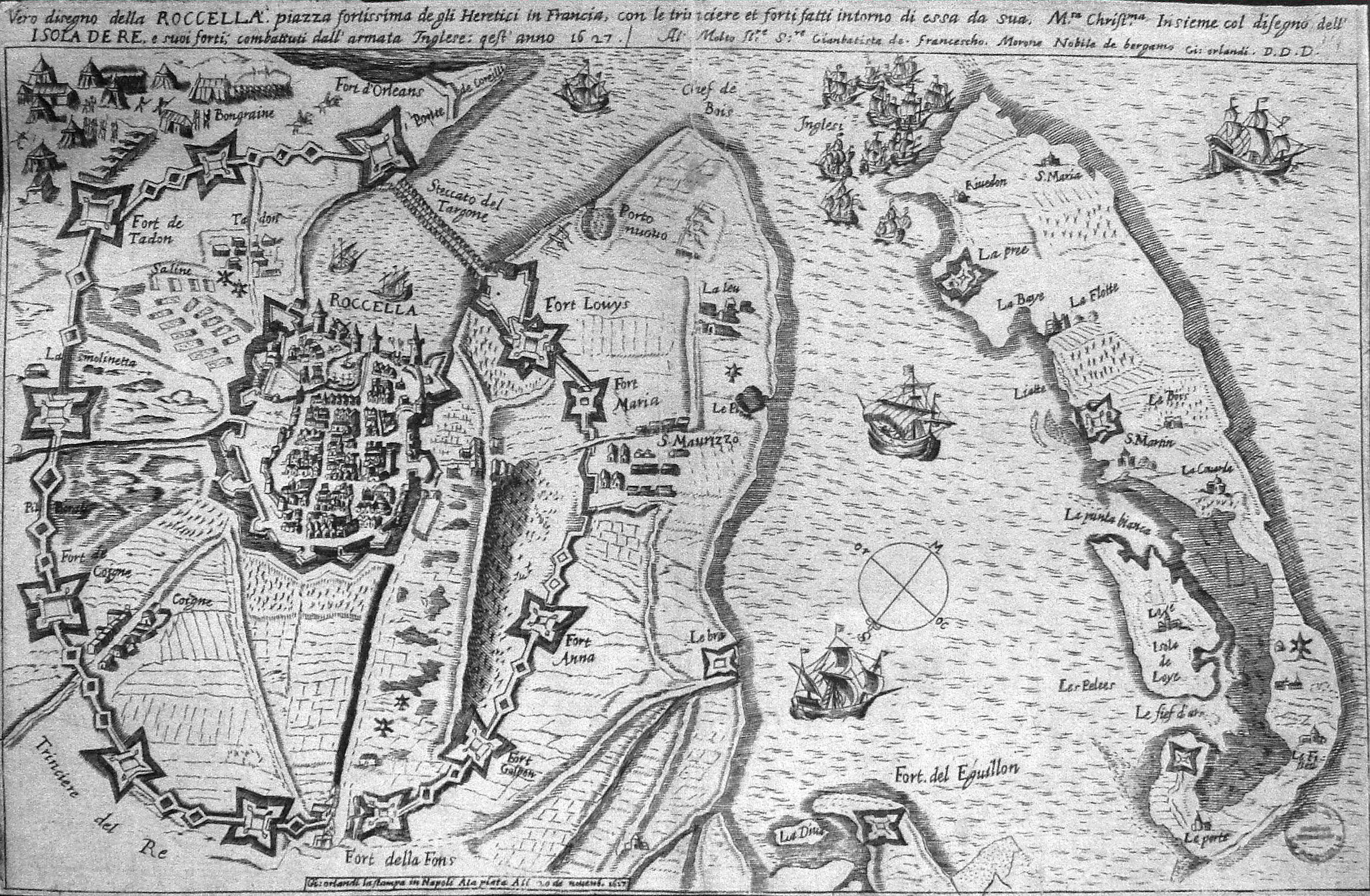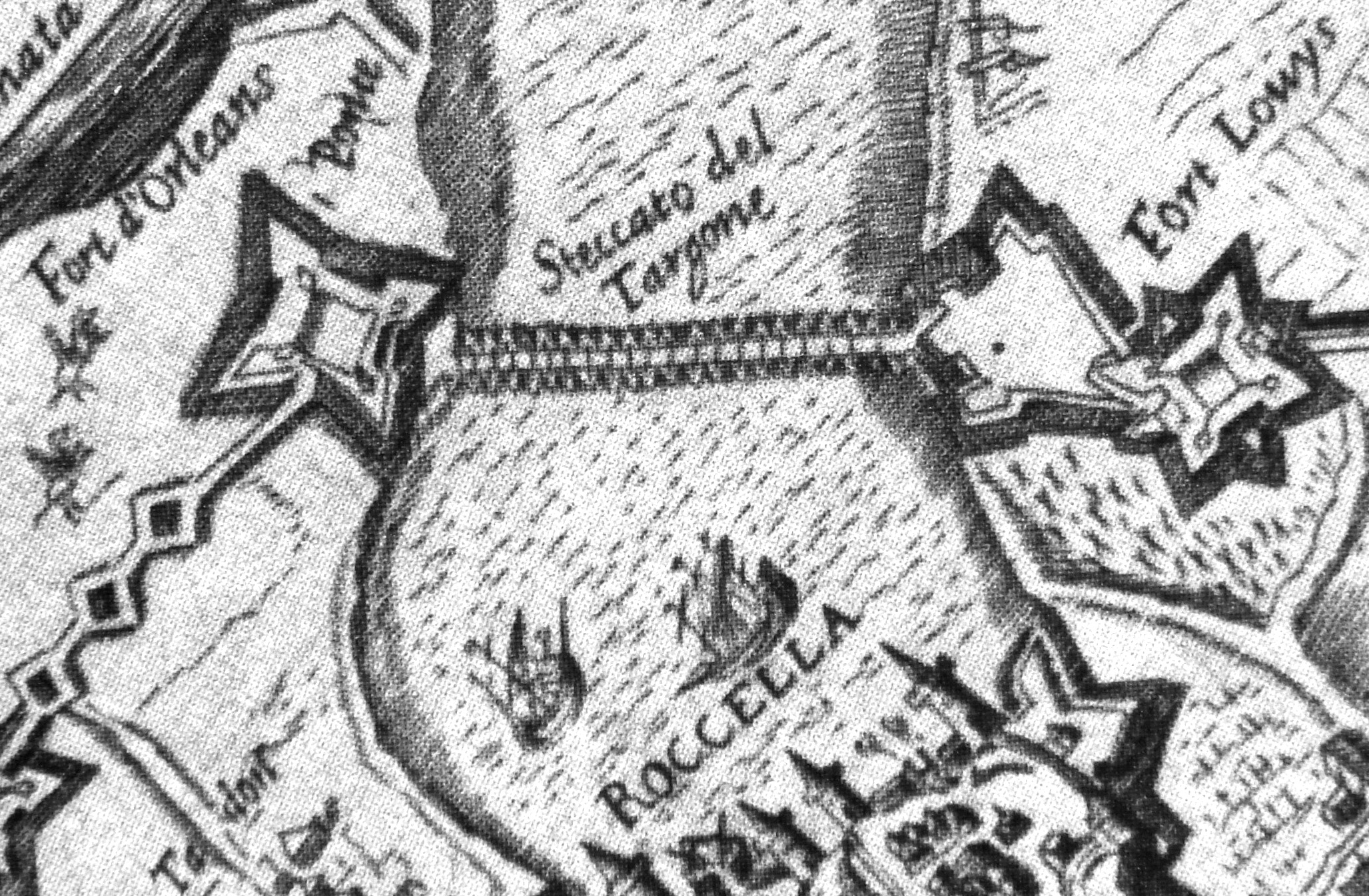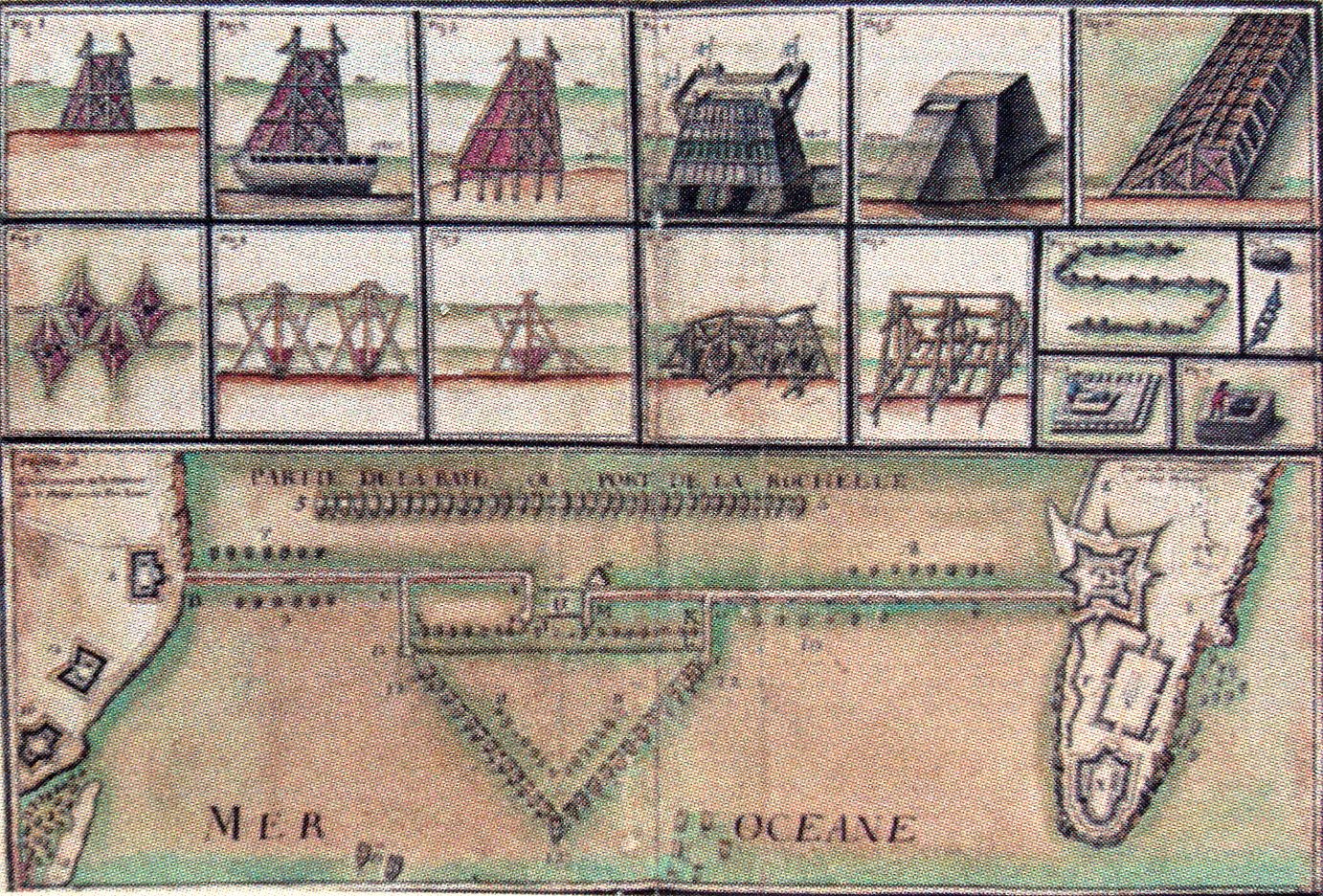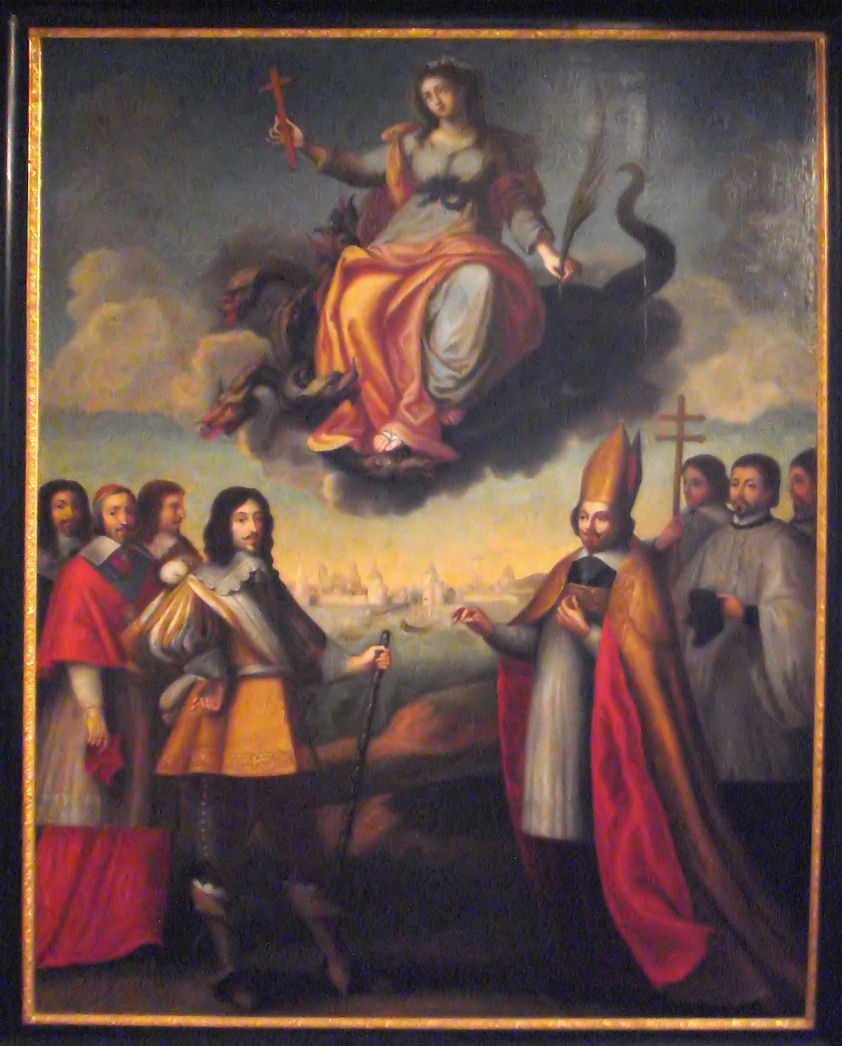La Rochelle Expedition on:
[Wikipedia]
[Google]
[Amazon]
The siege of La Rochelle (, or sometimes ) was a result of a war between the French royal forces of Louis XIII of France and the Huguenots of La Rochelle in 1627–28. The siege marked the height of the struggle between the
 The 1598 Edict of Nantes that ended the French Wars of Religion granted Protestants, commonly known as Huguenots, a large degree of autonomy and self-rule. La Rochelle was the centre of Huguenot seapower, and a key point of resistance against the Catholic royal government.
The assassination of Henry IV of France in 1610 led to the appointment of
The 1598 Edict of Nantes that ended the French Wars of Religion granted Protestants, commonly known as Huguenots, a large degree of autonomy and self-rule. La Rochelle was the centre of Huguenot seapower, and a key point of resistance against the Catholic royal government.
The assassination of Henry IV of France in 1610 led to the appointment of
/ref> In June 1626,






 Meanwhile, in August 1627 French royal forces started to surround La Rochelle, with an army of 7,000 soldiers, 600 horses, and 24 cannons, led by Charles of Angoulême. They started to reinforce fortifications at Bongraine (modern
Meanwhile, in August 1627 French royal forces started to surround La Rochelle, with an army of 7,000 soldiers, 600 horses, and 24 cannons, led by Charles of Angoulême. They started to reinforce fortifications at Bongraine (modern

/ref> Richelieu accepted Spanish help, and a Spanish fleet of 30 to 40 warships was sent from Cadiz to the Gulf of Morbihan as an affirmation of strategic support, arriving three weeks after the departure of Buckingham from Île de Ré. At one point, the Spanish fleet anchored in front of La Rochelle, but did not engage in actual operations against the city.
/ref>


 Residents of La Rochelle had resisted for 14 months, under the leadership of the mayor
Residents of La Rochelle had resisted for 14 months, under the leadership of the mayor
File:Siege de la Rochelle par louis XIII et Richelieu du 10 aout 1627 au 28 octobre 1628 planche 1 Jacques Callot 1592 1635.jpg, The Siege of La Rochelle, plate 1.
File:Siege de la Rochelle par louis XIII et Richelieu du 10 aout 1627 au 28 octobre 1628 planche 2 Jacques Callot 1592 1635.jpg, Plate 2: the sea wall and
File:Siege de la Rochelle par louis XIII et Richelieu du 10 aout 1627 au 28 octobre 1628 planche 4 Jacques Callot 1592 1635.jpg, Plate 4: area of La Pallice and Laleu.
File:Siege de la Rochelle par louis XIII et Richelieu du 10 aout 1627 au 28 octobre 1628 planche 5 Jacques Callot 1592 1635.jpg, Plate 5: overview of La Rochelle surrounded.
File:Siege de la Rochelle par louis XIII et Richelieu du 10 aout 1627 au 28 octobre 1628 planche 6 Jacques Callot 1592 1635.jpg, Plate 6.
File: City_of_La_Rochelle_and_fortifications_during_the_siege_anonymous_17th_century.jpg, City of La Rochelle and fortifications during the siege, anonymous, 17th century, Versailles.
File:Siege of La Rochelle by Claude Lorrain Le Louvre.jpg, ''Siege of La Rochelle'' by
File:Lucerna Impiorum Extinguetur Louis XIII 1626.jpg, ''Lucerna Impiorum Extinguetur'' ("The impious lantern is extinguished"), 1626.
File:Two dogs in the water around the reflect of a crown 1627.jpg, Two dogs in the water around the reflection of a crown 1627.
File:Dragon and lion mastered 1628.jpg, Dragon (La Rochelle) and lion (England) mastered under Royal arm, 1628.
File:Lionness captured behind a seawall 1628.jpg, Lionness captured behind a seawall, 1628.
File:Sea monster cut in two by a seawall.jpg, Sea monster cut in two by the seawall, 1628.
File:Snail pierced by an arrow on a raft Esto Domi 1628.jpg, English snail pierced by an arrow on a raft, ''Esto Domi'' ("Go Home"), 1628.
File:Vanquished English ship Tellus decepit et Unda Louis XIII 1629.jpg, Vanquished English ship, ''Tellus decepit et Unda'', 1629.
Catholics
The Catholic Church, also known as the Roman Catholic Church, is the largest Christian church, with 1.3 billion baptized Catholics worldwide . It is among the world's oldest and largest international institutions, and has played a ...
and the Protestants
Protestantism is a branch of Christianity that follows the theological tenets of the Protestant Reformation, a movement that began seeking to reform the Catholic Church from within in the 16th century against what its followers perceived to b ...
in France, and ended with a complete victory for King Louis XIII and the Catholics.
Background
Marie de' Medici
Marie de' Medici (french: link=no, Marie de Médicis, it, link=no, Maria de' Medici; 26 April 1575 – 3 July 1642) was Queen of France and Navarre as the second wife of King Henry IV of France of the House of Bourbon, and Regent of the Kingdom ...
as regent for her nine-year-old son, Louis XIII. Her removal in 1617 caused a series of revolts by powerful regional nobles, both Catholic and Protestant, while religious tensions were heightened by the outbreak of the 1618 to 1648 Thirty Years War. In 1621, Louis re-established Catholicism in the formerly Huguenot region of Béarn
The Béarn (; ; oc, Bearn or ''Biarn''; eu, Bearno or ''Biarno''; or ''Bearnia'') is one of the traditional provinces of France, located in the Pyrenees mountains and in the plain at their feet, in southwest France. Along with the three Bas ...
, resulting in an uprising
Rebellion, uprising, or insurrection is a refusal of obedience or order. It refers to the open resistance against the orders of an established authority.
A rebellion originates from a sentiment of indignation and disapproval of a situation and ...
led by Henri de Rohan and his brother Soubise.
Despite the Royalist capture of Saint-Jean d'Angély, a blockade of La Rochelle was unsuccessful and the revolt ended in stalemate with the October 1622 Treaty of Montpellier. Taking La Rochelle was a priority for Louis and his chief minister Cardinal Richelieu
Armand Jean du Plessis, Duke of Richelieu (; 9 September 1585 – 4 December 1642), known as Cardinal Richelieu, was a French clergyman and statesman. He was also known as ''l'Éminence rouge'', or "the Red Eminence", a term derived from the ...
; it was then the second- or third-largest city in France, with over 30,000 inhabitants, and one of its most important ports. In addition to the customs duties generated by imports, it was also among the biggest producers of salt, a major source of taxes for the state; this made it economically crucial.
Defeating Rohan and taking possession of La Rochelle were both essential for Richelieu's policy of centralisation, but since the French Crown did not have a navy strong enough to capture it, he asked England for help. When James I refused, he approached the Dutch Republic. The Huguenots were supported by Spain, who the Protestant Dutch were then fighting for their independence; in return for French subsidies, they agreed to provide naval backing in the 1624 Treaty of Compiègne.
English intervention
The Anglo-French conflict followed the failure of their alliance of 1624, in which England had tried to find an ally in France against the power of theHabsburg
The House of Habsburg (), alternatively spelled Hapsburg in Englishgerman: Haus Habsburg, ; es, Casa de Habsburgo; hu, Habsburg család, it, Casa di Asburgo, nl, Huis van Habsburg, pl, dom Habsburgów, pt, Casa de Habsburgo, la, Domus Hab ...
s. In 1626, France under Richelieu
Richelieu (, ; ) may refer to:
People
* Cardinal Richelieu (Armand-Jean du Plessis, 1585–1642), Louis XIII's chief minister
* Alphonse-Louis du Plessis de Richelieu (1582–1653), French Carthusian bishop and Cardinal
* Louis François Armand ...
concluded a secret peace with Spain, and disputes arose around Henrietta Maria's household. Furthermore, France was building the power of its navy, leading the English to be convinced that France must be opposed "for reasons of state".''Historical dictionary of Stuart England, 1603–1689'' by Ronald H. Fritze, p. 20/ref> In June 1626,
Walter Montagu
Walter Montagu (c. 1603–1677) was an English courtier, secret agent (a.k.a. David Cutler) and Benedictine abbot.
Life
He was the second son of Henry Montagu, 1st Earl of Manchester, by his first wife Catherine Spencer. He was born in the par ...
was sent to France to contact dissident noblemen, and from March 1627 attempted to organize a French rebellion. The plan was to send an English fleet to encourage rebellion, triggering a new Huguenot revolt by Duke Henri de Rohan and his brother Soubise.
First La Rochelle expedition
On the first expedition, King Charles I sent a fleet of over 100 ships, under his favouriteGeorge Villiers, 1st Duke of Buckingham
George Villiers, 1st Duke of Buckingham, 28 August 1592 – 23 August 1628), was an English courtier, statesman, and patron of the arts. He was a favourite and possibly also a lover of King James I of England. Buckingham remained at the ...
, to encourage a major rebellion in La Rochelle. In June 1627, Buckingham organised a landing on the nearby island of Île de Ré with 6,000 men in order to help the Huguenots, thus starting the Anglo-French War of 1627
Anglo-French (or sometimes Franco-British) may refer to:
*France–United Kingdom relations
* Anglo-Norman language or its decendants, varieties of French used in medieval England
*Anglo-Français and Français (hound), an ancient type of hunting ...
, with the objectives being to control the approaches to La Rochelle and to encourage the rebellion in the city.
The city of La Rochelle initially refused to declare itself an ally of Buckingham against the crown of France and effectively denied access to its harbour to Buckingham's fleet. An open alliance would be declared only in September, during the first fights between La Rochelle and royal troops.
Although it was a Protestant stronghold, Île de Ré had not directly joined the rebellion against the king. On Île de Ré, the English under Buckingham tried to take the fortified city of Saint-Martin in the siege of Saint-Martin-de-Ré (1627) but were repulsed after three months. Small French royal boats managed to supply St Martin in spite of the English blockade. Buckingham ultimately ran out of money and support, and his army was weakened by disease. After a last attack on Saint-Martin, they were repulsed with heavy casualties and left with their ships.
Siege






 Meanwhile, in August 1627 French royal forces started to surround La Rochelle, with an army of 7,000 soldiers, 600 horses, and 24 cannons, led by Charles of Angoulême. They started to reinforce fortifications at Bongraine (modern
Meanwhile, in August 1627 French royal forces started to surround La Rochelle, with an army of 7,000 soldiers, 600 horses, and 24 cannons, led by Charles of Angoulême. They started to reinforce fortifications at Bongraine (modern Les Minimes
Les Minimes, Port de plaisance des Minimes, is the largest marina in France for pleasure boats. It is located in the city of La Rochelle.
Its name is derived from the establishment of a convent of the Frères Minimes ("Order of the Minimes Brot ...
), and at the Fort Louis.
On September 10, the first cannon shots were fired by La Rochelle against royal troops at Fort Louis, starting the third Huguenot rebellion. La Rochelle was the greatest stronghold among the Huguenot cities of France, and the centre of Huguenot resistance. Cardinal Richelieu acted as commander of the besiegers when the King was absent.
Once hostilities started, French engineers isolated the city with entrenchments long, fortified by 11 forts and 18 redoubts. The surrounding fortifications were completed in April 1628, manned with an army of 30,000.
Four thousand workmen also built a long seawall to block the seaward access between the city and harbor, stopping all supplies. The initial idea for blocking the channel came from the Italian engineer Pompeo Targone
Pompeo Targone (1575 – c. 1630), son of a Venetian goldsmith, was an Italian engineer in the service of popes Clement VIII and Paul V. He built the ciborium tabernacle in the Blessed Sacrament chapel of the Archbasilica of St. John Lateran, an ...
, but his structure was broken by winter weather, before the idea was taken up by the royal architect Clément Métezeau
Clement or Clément may refer to:
People
* Clement (name), a given name and surname
* Saint Clement (disambiguation)#People
Places
* Clément, French Guiana, a town
* Clement, Missouri, U.S.
* Clement Township, Michigan, U.S.
Other uses
* A ...
in November 1627. The wall was built on a foundation of sunken hulks filled with rubble. French artillery battered English ships trying to supply the city.
Meanwhile, in southern France, Henri de Rohan vainly attempted to raise a rebellion to relieve La Rochelle. Until February, some ships were able to go through the seawall under construction, but after March this became impossible. The city was completely blockaded, with the only hope coming from possible intervention by an English fleet.
Foreign support for the French Crown

Dutch support
The Roman Catholic government of France rented ships from the Protestant city of Amsterdam to conquer the Protestant city of La Rochelle. This resulted in a debate in the city council of Amsterdam as to whether the French soldiers should be allowed to have a Roman Catholic sermon on board of the Protestant Dutch ships. The result of the debate was that it was not allowed. The Dutch ships transported the French soldiers to La Rochelle. France was a Dutch ally in the war against theHabsburg
The House of Habsburg (), alternatively spelled Hapsburg in Englishgerman: Haus Habsburg, ; es, Casa de Habsburgo; hu, Habsburg család, it, Casa di Asburgo, nl, Huis van Habsburg, pl, dom Habsburgów, pt, Casa de Habsburgo, la, Domus Hab ...
s.
Spanish alliance
In the occasion of the siege of La Rochelle, Spain manoeuvered towards the formation of a Franco-Spanish alliance against the common enemies that were the English, the Huguenots, and the Dutch.''The Thirty Years' War'' by Geoffrey Parker, p. 74/ref> Richelieu accepted Spanish help, and a Spanish fleet of 30 to 40 warships was sent from Cadiz to the Gulf of Morbihan as an affirmation of strategic support, arriving three weeks after the departure of Buckingham from Île de Ré. At one point, the Spanish fleet anchored in front of La Rochelle, but did not engage in actual operations against the city.
English relief efforts
England attempted to send two more fleets to relieve La Rochelle.Second La Rochelle expedition
A naval force led by William Feilding, Earl of Denbigh, left in April 1628, but returned without a fight to Portsmouth, as Denbigh said that he had no commission to hazard the king's ships in a fight, and returned shamefully to Portsmouth.''An apprenticeship in arms'' by Roger Burrow Manning, p. 119/ref>
Third La Rochelle expedition
A third fleet was dispatched under the Admiral of the Fleet, the Earl of Lindsey in August 1628, consisting of 29 warships and 31 merchantmen. In September 1628, the English fleet tried to relieve the city. After bombarding French positions and failing to force the sea wall, the English fleet had to withdraw. Following this last disappointment, the city surrendered on 28 October 1628.Epilogue


 Residents of La Rochelle had resisted for 14 months, under the leadership of the mayor
Residents of La Rochelle had resisted for 14 months, under the leadership of the mayor Jean Guitton
Jean Guitton (August 18, 1901 – March 21, 1999) was a French Catholic philosopher and theologian.
Biography
Born in Saint-Étienne, Loire in August 1901, he studied at the Lycée du Parc in Lyon and was accepted at the École Normale Sup� ...
and with gradually diminishing help from England. During the siege, the population of La Rochelle decreased from 27,000 to 5,000 due to casualties, famine, and disease.
Surrender was unconditional. By the terms of the Peace of Alais
Peace is a concept of societal friendship and harmony in the absence of hostility and violence. In a social sense, peace is commonly used to mean a lack of conflict (such as war) and freedom from fear of violence between individuals or groups. ...
, the Huguenots lost their territorial, political, and military rights, but retained the religious freedom granted by the Edict of Nantes. However, they were left at the mercy of the monarchy, unable to resist later when Louis XIV abolished the Edict of Nantes altogether and embarked on active persecution.
Aside from its religious aspect, the siege of La Rochelle marks an important success in the creation of a strong central government of France, in control throughout its territory and able to suppress regional defiance. In the immediate aftermath was the growth of the absolute monarchy, but it had long-term effects upon all later French regimes up to the present.
The French philosopher Descartes is known to have visited the scene of the siege in 1627.
The siege was depicted in detail by numerous artists, such as Jacques Callot.
Birdeye views by Jacques Callot
Les Minimes
Les Minimes, Port de plaisance des Minimes, is the largest marina in France for pleasure boats. It is located in the city of La Rochelle.
Its name is derived from the establishment of a convent of the Frères Minimes ("Order of the Minimes Brot ...
.
File:Siege de la Rochelle par louis XIII et Richelieu du 10 aout 1627 au 28 octobre 1628 planche 3 Jacques Callot 1592 1635.jpg, Plate 3: Aytré
Aytré () is a commune in the Charente-Maritime department, Nouvelle-Aquitaine, southwestern France.
Aytré is especially known for its long beach, which is easily accessible from neighbouring La Rochelle, or Les Minimes. The beach is flat and sh ...
.
Maps by Jacques Callot
Others
Claude Lorrain
Claude Lorrain (; born Claude Gellée , called ''le Lorrain'' in French; traditionally just Claude in English; c. 1600 – 23 November 1682) was a French painter, draughtsman and etcher of the Baroque era. He spent most of his life in It ...
, Le Louvre
The Louvre ( ), or the Louvre Museum ( ), is the world's most-visited museum, and an historic landmark in Paris, France. It is the home of some of the best-known works of art, including the ''Mona Lisa'' and the ''Venus de Milo''. A central l ...
.
Image:LaRochelleSiegeMap.jpg, The Siege of La Rochelle by Jacques Callot, with the English fleet of the Earl of Lindsey approaching.
Numismatics
Around the time of the siege, a series of propaganda coins were cast to describe the stakes of the siege, and then commemorate the Royal victory. These coins depict the siege in symbolic ways, showing the city and the English effort in a poor light, while putting an advantageous light on Royal might.Musée d'Orbigny-Bernon
The Orbigny-Bernon Museum ( French: ''Musée d'Orbigny-Bernon'', ) is a history museum in the French city of La Rochelle.
It was founded in 1917, and contains collections relating to the history of La Rochelle, as well as an important collectio ...
exhibit
In popular culture
The siege forms the historical background for the novel '' The Three Musketeers'' byAlexandre Dumas, père
Alexandre Dumas (, ; ; born Dumas Davy de la Pailleterie (), 24 July 1802 – 5 December 1870), also known as Alexandre Dumas père (where ''Suffix (name)#Generational titles, '' is French language, French for 'father', to distinguish him from ...
and the book's numerous adaptations to stage, screen, comics and video game.
The 11th book of Robert Merle
Robert Merle (; 28 August 1908 – 27 March 2004) was a French novelist.
Early life
Merle was born in 1908 in Tébessa, French Algeria. His father Félix, who was an interpreter "with a perfect knowledge of literary and spoken Arabic", was kille ...
's ''Fortune de France
''Fortune de France'' (''Fortunes of France'') is a sequence of 13 historical novels by French author Robert Merle, published between 1977 and 2003. The series is about 16th and 17th century France through the eyes of a fictitious Huguenot do ...
'' series, ''La Gloire et les perils'', deals entirely with the siege.
In Lawrence Norfolk's 1991 novel, ''Lemprière's Dictionary'', the siege is the central cause of events (entirely fictional) 160 years later in London around the writing of John Lemprière
John Lemprière (c. 1765, Jersey – 1 February 1824, London) was an English classical scholar, lexicographer, theologian, teacher and headmaster.
Life
John Lemprière was the son of Charles Lemprière (died 1801), of Mont au Prêtre, Jersey.
...
's ''Classical Dictionary containing a full Account of all the Proper Names mentioned in Ancient Authors''.
Taylor Caldwell
Janet Miriam Caldwell (September 7, 1900August 30, 1985) was a British-born American novelist and prolific author of popular fiction under the pen names Taylor Caldwell, Marcus Holland and Max Reiner. She was also known by a variation of her mar ...
writes about the siege in great detail in her 1943 novel ''The Arm and the Darkness'' but has as its commander the fictional Huguenot nobleman Arsene de Richepin, one of the central characters of the book.
References
Sources
* * * * * * {{Authority control Huguenot rebellions 1620s conflicts La Rochelle 1627 in France 1628 in France La Rochelle 1627 History of Charente-Maritime La Rochelle Battles of the Thirty Years' War England–France relations